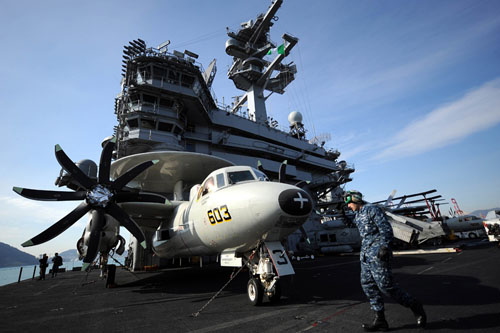US forcing China to boost its military
|
 |
|
Crew members work on the deck of the U.S. aircraft carrier USS Carl Vinson which is anchored at a South Korean navy port in Busan, South Korea, on Jan. 11, 2011. [Xinhua] |
The U.S. has recently been flexing its military muscle in waters off the Korean Peninsula while simultaneously deploying additional troops in the western Pacific region. The troop deployments have created a new configuration of forces, with Hawaii, Guam and Okinawa as strategic islands, and carrier combat groups delivering troop transport capability.
The US troop deployments have upset the balance of forces in the western Pacific. They are changing the military pattern in East Asia, and pose a serious threat to China.
The Chinese navy's sea routes are under serious threat. The U.S. is currently planning to deploy three carrier combat groups in the western Pacific region. If this deployment becomes routine it will constitute a major threat to eastern China, and will allow US forces to closely monitor all activities of the Chinese navy in the western Pacific.
Northeast China will also come under military pressure. South Korea's armed forces, supported by the US military, are a serious threat to North Korea. The North will inevitably respond and, consequently, tensions on the Korean Peninsula are unlikely to ease in the short term. This, in turn, will force China to make precautionary military deployments in northeast China.
In order to safeguard its global power, the U.S. is likely to help its partners, Japan and South Korea, boost their military capabilities. But the likely result will be to trigger a new arms race in East Asia.
The U.S. is shifting its strategic focus from Europe to the Asia-Pacific region. China is directly affected by large scale US military maneuvers in the western Pacific. But how should China deal with the growing US military presence? How can peace and stability be maintained in the region? How can the regional pattern of military power be maintained? Unlike the former Soviet Union, China is unlikely to engage in a comprehensive arms race with the U.S.
Faced with a military threat from the U.S., China has to improve its key fighting forces and strengthen its overall military power. The key to this process is making breakthroughs in military technology. Such breakthroughs would help to restore the military balance in the western Pacific, and would also provide beneficial spin-offs to civilian technology.
The U.S. has disturbed the military balance in the western Pacific region. But a decision to call a halt to its military maneuvers would help slow the developing regional arms race.
Han Xudong is a professor at the University of National Defense of the Chinese People's Liberation Army.
(The article was translated by Zhang Ming'ai.)
 0
0 






